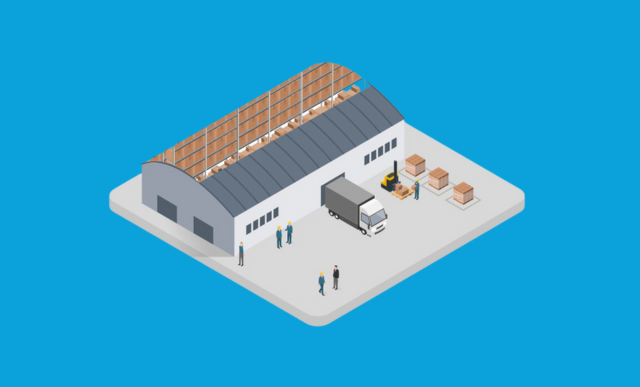Boosting Warehouse Management with SAP S/4HANA
Advanced Functionality in SAP S/4HANA Enhances Warehouse Management Operations
The supply chain is undergoing massive change due to digitization, with faster planning, production, and delivery combining with higher expectations from customers to change how goods are produced, packaged, and shipped at companies around the world. And while there has been much focus around new ways of developing products and reducing shipping times, one area that must not be left behind is the warehouse.
A key part of an end-to-end logistics process, warehouse management involves managing the operations of the warehouse — where goods are stored, how they are transported from one location to the next, and how vehicles involved in shipping and delivery maneuver around the facility. Consider the effects on the supply chain — and the business as a whole — for a company that focuses its technological resources on other components of the business and not the warehouse.
The company might invest in a better finance solution to achieve a faster close and easier insight into its day-to-day financials, but without advanced warehouse functionality, it might not have insight into current inventory levels. The company might invest in a best-of-breed HR solution, but by failing to keep up to date in the warehouse, employee productivity could decline due to workers having to make up for manual error, or employees who don’t trust an unreliable system and don’t use it at all. The same is true for companies that invest in upgrades for parts of their supply chain — setting up advanced business networks or upgrading production processes, for example — but forget about their warehouse, thinking that they can get by with what they have always had.
This way of thinking ignores four key drivers of the digital supply chain: the customer experience, individualized products, the networked economy, and resource scarcity (see the sidebar below). These trends are causing an upheaval in how the supply chain performs, and to address them all, organizations need to make sure their warehouse management functionality is up to date. This is why SAP brought extended warehouse management to SAP S/4HANA as part of the digital core, providing the real-time insight and analysis manufacturers need to maximize the efficiency of their warehouses, cut down on wasted costs and errors, boost customer satisfaction and profitability, and better integrate warehouse management into the end-to-end logistics process. Let’s take a closer look at these features and how they help organizations better integrate warehouse management into the end-to-end logistics process that powers the modern supply chain.
Extended Warehouse Management in SAP S/4HANA
Warehouse management is a key component of the end-to-end logistics process. It is all about accelerating order delivery and reducing manual errors, which not only lead to increased costs, but also can affect a company’s brand if a customer’s delivery expectations are not met. Companies have long had basic warehouse management features in place in their classical ERP systems to mitigate these risks, but today’s demands on the supply chain require more advanced features, such as real-time insight into inventory — features that, in the past, often required a separate solution, such as SAP Extended Warehouse Management, due to performance and speed limitations of classical hard disk-based databases. With SAP S/4HANA, this is no longer the case — these advanced features are now alongside the basic warehouse processes as part of one solution.
As of the 1610 release of SAP S/4HANA, extended warehouse management functionality is available in SAP S/4HANA to meet the needs of digital supply chains. These extended warehouse management functionalities allow for better physical storage, slotting, replenishment, and rearrangement. They can also help organizations identify the best location for storing materials and maintain control over the entire process while keeping in mind physical constraints. Added visibility means that changes to orders can be more easily accommodated because the warehouse manager has a solid understanding of what goods are in inventory, and where they are.
For example, extended warehouse management functionality in SAP S/4HANA enables the ability to optimize inbound and outbound processes, which leads to a more efficient process flow. From a logistics perspective, companies can control the physical processes at a much more granular level than they could before, breaking down deliveries into work orders and warehouse tasks. For outbound deliveries, better packing and packaging means fewer errors, and with increased process efficiency, companies can handle greater volumes of orders at a faster speed, meaning customers get their deliveries more quickly and as expected.
Another example is how extended warehouse management functionality helps companies optimize the logistics process within physical constraints, such as incoming trucks or ships with goods that need to be parked or docked for a certain period. For instance, it allows organizations to see what parking spots will be available when, which gate the truck should enter through, and how to optimize the offloading and loading of goods before the truck goes back out for its next trip. Or let’s say a ship arrives with goods — using the advanced analysis features in extended warehouse management in SAP S/4HANA, a company might realize that, rather than storing the goods in the warehouse, it can achieve better flow of materials by combining the goods with another shipment, and send the ship back out without unloading it at all. In both cases, the result is more efficient resource utilization and operations due to digital insights, meaning faster, better supply chain operations.
Go Beyond the Warehouse
A key benefit of bringing the extended warehouse management functionality into SAP S/4HANA is that it better integrates warehouse management into the end-to-end logistics process that is the foundation for your digital supply chain. With added speed and data integration into other parts of your business, you enable better sharing of up-to-the-minute, accurate data, which translates into not only more efficient operations in the short term, but the ability to uncover — and eliminate — unneeded processes that are being repeated, paving the way to long-term efficiency.
Extended warehouse management in SAP S/4HANA can help companies innovate their warehouse processes and operate in a leaner fashion going forward — even companies that already have advanced warehouse management capabilities, albeit in separate, decentralized systems now have the option to consolidate their systems by moving to SAP S/4HANA. With the advanced warehouse management features and functionality included SAP S/4HANA, manufacturers can not only separate themselves from their competitors, but also stave off competition from smaller start-ups that have entered the manufacturing space from another industry altogether. With more efficient storage, packing, and shipping, warehouses can keep up with the demands of the modern consumer by playing a key role in the fast manufacture and delivery of goods.
For more information, visit www.sap.com/product/enterprise-management/s4hana-erp.html.







